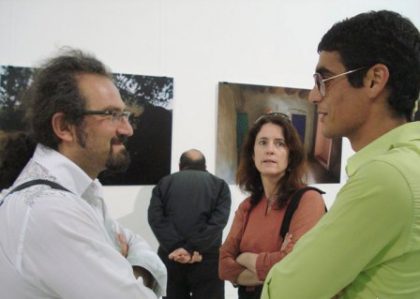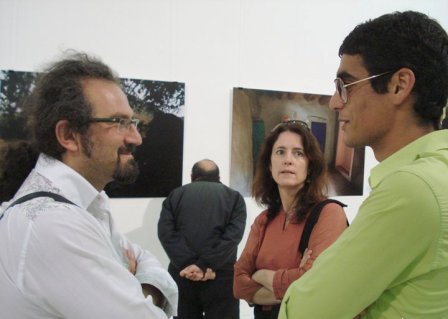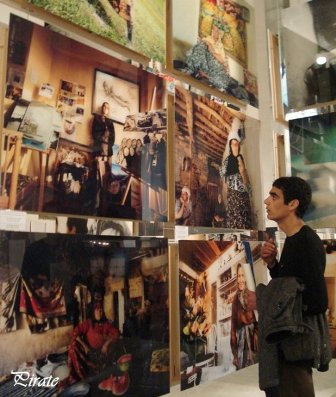
 The Language of culture in the service of dialogue
The Language of culture in the service of dialogue
Azad-Hye Special
Boris Tamoyan
On 05 May 2011 the photography exhibition of Turkish national Attila Durak dedicated to Ebru art was opened in the Armenian Center for Contemporary and Experimental Arts in Yerevan.
Ebru is a water based painting. Its English translation means “marbled paper”. Durak Attila's Ebru is a photography project that focuses on cultural diversity in Turkey. It consists of a photo book, series of exhibitions and seminars. The project started in 2000. During the first five years Durak went to many cities, towns and villages in Turkey and took 15.000 frames covering photography work with 44 ethnic groups in Turkey.
Fethiye Cetin (attorney), Nebahat Akoch (educational instructor), Ayse Gul Altinay (lecturer) and Takuhi Tovmasian (a Turkish Armenian from Aras Press) took part in the forum besides Attila Durak.
The 203 ebru photographic works depicted the daily life of ethnic groups in Turkey. The discussions were titled: “From Ebru to Grandchildren: New Conceptualizations of Cultural Diversity in Turkey”. Ebru is an art that is used to design the cover and first pages of books.
The book of 350 pages is the result of Durak's constant visits to different areas in Turkey where different cultures exist. The idea behind it is to reflect the diversity of Turkey and to show that “Turkey is for Turks” concept should be replaced with one that can bring together different groups.
Attila had 10 exhibitions in Turkey and more than that outside Turkey. Yerevan is the location for the 27th exhibition. He explained the difficulties in obtaining photos. He said “If my photos can reflect my love and respect towards the people of my country, if they are able to express hardship, sadness, suffering and beauty, then I would say I have painted an ebru with exceptional colors”.
The exhibition continued until 30th May 2011
Photo: Azad-Hye journalist Boris Tamoyan in the exhibition hall and during the interview with the artist.
TEXT IN ARMENIAN
Մշակույթի լեզուն հանուն երկխոսության
Բորիս Թամոյան
Մայիսի 5ին Երևանի Նորարար փորձառական արվեստի կենտրոնում (ՆՓԱԿ), տեղի ունեցավ ազգությամբ թուրք լուսանկարչի Աթիլլա Դուրաքի ցուցահանդես, քննարկումը որը կրում էր Թուրքիայի մշակույթային բազմազանության արտացոլումներ խորագիրը:
Քննարկմանը մասնակցում էին Ֆեթիյե Չեթինը (փաստաբան), Նեբահաթ Աքոջը (ուսուցիչ), Այշե Գյուլ Ալթնայը (դասախոս) և հայազգի Թագուհի Թովմասյանը (գրող):
Ներկայացված էր շուրջ 203 լուսանկար, որոնցում նկարագրված էր Թուրքիայում բնակվող էթնիկ խմբերի կենցաղը, ապրելաձևը: Մինչ բուն բացման արարողությունը լուսանկարիչը և կազմակերպիչները ունեցան ?Էբրու-ից մինչ թոռներ. նոր հայեցակարգեր Թուրքիայում? թեմայով քննարկում: Էբրուն արվեստի տեսակ է, որն օգտագործվում է գրքերի առաջին էջերը տարբեր գույներով և երանգներով ձևավորելու նպատակով: Այն բնորոշ է Թուրքիայի հասարակությանը: Այսօր Թուրքիայում հայտնվում է մի նոր սերունդ, ?թոռներ?, ովքեր վերագտնում են իրենց հայկական ինքնությունը: Նրա 7 տարվա ճամփորդությունների 350 էջանոց գիրքն է: Քննարկման նպատակն է ազատ զրույց ծավալել մարդկանց միջև, ովքեր հասկանում են պատմությունն ընդունելու կարևորությունը և հարգում մարդու իրավունքները: Աթթիլան իր խոսքում նշեց որ նա դեմ է Թուրքիան թուրքերինն է կարգախոսին, մշակույթները պետք է համախմբվեն և գնան զարգացում:
Աթթիլա Դուրաքը շատ ցուցահանդեսններ է ունեցել' Թուրքիայի 10 քաղաքներում, Ֆրանսիայում, Շվեյցարիայում և 27րդ էլ այստեղ է' Երևանում: Նա մի փոքր ներկայացրեց նկարները ստանալու բարդությունները, օրինակ' եզդիներին նկարելու համար նա 18 օր սպասել է, քանի որ կարծում էին այդ քայլը կվնասի իրենց: Նաև պատմում է, որ մարդիկ էլ կային որ իրենց չնկարեիր, իրենք իրենց կնկարեին: Ցուցահանդեսում ներկայացված նկարները առանձնանում էին իրենց գույներով և ազդեցիկությամբ: Լուսանկարիչ Աթիլլա Դուրակը այսպես արտահայտվեց իր նկարների մասին. -?Եթե նկարներս կարողանան արտացոլել երկրիս մարդկանց նկատմամբ իմ տածած խորը սերը և հարգանքը, եթե կարողանան արտահայտել նրանց ողջ տքնանքը, տխրությունը և տառապանքը, տարբերությունից և տառապանքից ծնված գեղեցկությունը, այդ դեպքում ընդունելու եմ, որ կարողացել եմ մի Էբրու լուսանկարել, որը իր գույներով ու առկայծումներով ամենևին սովորական չէր և որը տեսել եմ մարդկանց կյանքում, և ինձ կհամարեմ հաջողակ?:
Ցուցահանդեսը բուռն քնարկումների թեմա էր դարձել' ինչին մենք ականատես եղան ընթերցելով ցուցասրահում դրված կարծիքներ մատյանը: Ցուցահանդեսը ՆՓԱԿ-ում շարունակվեց մինչև մայիսի 30?ը:
 ADDITIONAL READING
ADDITIONAL READING
The idea of applying this concept of 'ebru' to the nature of cultural identity and diversity in Turkey emerged from Attila Durak's long journey of curiosity, passion, and hard work. As such, it is a metaphor that offers a promising alternative to others like 'the 'mosaic' or 'the quilt' for thinking through the new and old dilemmas of cultural politics.
Ebru is an invitation to open up our minds and hearts to the humbling fluidity, the enduring vitality and strength, and the courageous sincerity in the photographs and stories.
THE BOOK
Edited by Ayşe G?l Altınay, the book presenting a selection of approximately 300 colour photographs and a number of essays by leading intellectuals such as Sezen Aksu, Elif Şafak, Murat Belge, Ara G?ler, İshak Alaton, and Tosun Terzioğlu and a foreword by John Berger was published in Turkish and in English by Metis Publishing in Turkey and in French by Actes Sud in France.
EXHIBITION
Reflections of Cultural Diversity, Attila Durak's photography exhibition that was shown 26 times in Turkey, America and Europe since it came to light in 2007. The exhibiton in Armenia's capital Yerevan opened on May 5, after a work of 3 years in the making.
The exhibition that opened at Yerevan's most important art gallery ACCEA – Armenian Center for Contemporary Experimental Art, is the biggest exhibition so far with 220 photographs displayed.
The exhibition?s panel discussion titled “From Ebru to Grandchildren: New Conceptualizations of (or Recent Debates on) Cultural Diversity in Turkey” will took place with the participation of Ebru's photographer Attila Durak, editor Ayşe G?l Altınay, and authors Fethiye ?etin, Takuhi Tovmasyan. Nebahat Akko? formerly annouced as one of the participants of the panel discussion and Akif Kurtuluş who was going to watch the Yerevan exhibition as an Ebru friend and a journalist, could not make it to the country, as they hold diplomatic passports and there is no diplomatic relationship between two countries.
During the largest panel discussion, with a crowd of 250 people, when an Armenian participant asked “I want to be a part of this convergence, this quest for the solution, what can I do?” and said “Let's applaud these heroes loudly” referring to the Ebru team, the whole hall stood up and applauded the panelists.
The press conference was held two days prior to the exhibition and the media showed great interest in the exhibition, all the main Armenian newspapers and televisions covered the exhibition.
As Attila Durak said in the press conference, we strongly wish that this exhibition initiates a dialogue through art; be an instrument in people understanding each other and seeing one another as human beings before their identities, and everyone who visits the exhibition looking at their inner ebru.
Ebru exhibition goes to Armenia
Ebru project is going to Armenia in May with its photography exhibition and panel discussion, wishing to establish dialogue through art between societies while presenting Turkey?s multiculturalism.
Ebru Project by photographer Attila Durak, which documents the multiculturalism in Turkey, will be meeting the art lovers in Armenia?s capital Yerevan in May, after reaching approximately 350.000 people with 11 exhibitions in Turkey, 2 in America and 13 in Europe.
The Ebru exhibition will open on May 5, 2011 in Yerevan?s most important art gallery ACCEA – Armenian Center for Contemporary Experimental Art and Turkey?s cultural richness will be shared with the art lovers from Armenia until the end of the month.
The exhibition?s panel discussion titled “From Ebru to Grandchildren: New Conceptualizations of (or Recent Debates on) Cultural Diversity in Turkey” will take place with the participation of Ebru's photographer Attila Durak, editor Ayşe G?l Altınay, and authors Fethiye ?etin, Takuhi Tovmasyan, and Nebahat Akko? with the Civilitas Foundation?s support at the same venue from 3 p.m. this panel seeks to share the journey of Ebru in Turkey and Europe. ?etin and Altınay will also discuss their recent book, Grandchildren, on Islamized Armenians in Turkey.
Turkey is experiencing the painful, yet very creative process of transformation from a plural to a pluralist polity and society. There are many dilemmas and a heavy historical burden to address in the process. Both Ebru and Grandchildren introduce new perspectives on how to rethink and reconceptualize cultural diversity in Turkey at this critical juncture. The widely diverse life stories and worldviews that converge in these two projects invite all of us to open up our minds and hearts to each other, as well as to our own ebruesque selves.
Institutions from Turkey and Armenia, and a part of the Armenian Diaspora in France rolled up their sleeves together maybe for the first time for an art project. The supporters of the exhibition are; Open Society Foundation, Hrant Dink Foundation, Fineco, Balnak, Bosch, Anadolu K?lt?r, Agos, Aras, Accea and Actual Art.
Ebru, with its photographs and its call for friendship, is a project that can help the societies of two countries know each other better, communicate and establish new bonds. Ebru?s tour has been pivotal in its role of facilitating a growing momentum of social, cultural and human compassion and understanding throughout the world since 2007 by creating opportunities for dialogue, encouraging individuals to tap into their inner ebru, and to rethink prejudices and stereotypes that are the unfortunate legacy of coexisting in contexts of social and cultural diversity. Using the evocative power of art, the project?s biggest aim is to share this momentum of compassion and understanding with Armenian society, in hopes of catalyzing greater mutual understanding, and creating an opportunity to revise and renew dialogues between individuals, between societies, and between nations.
